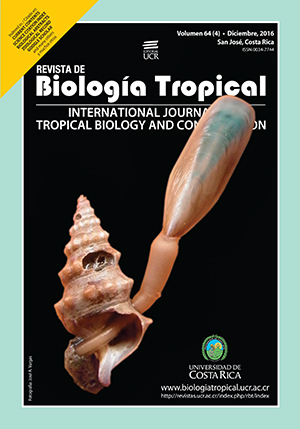Abstract
Several illnesses of vectorial origin have a great medical and veterinary relevance, due to the adaptations developed by the species involved in their transmission. To support preventive programs with updated ecological information of Ae. aegypti populations, an entomological survey was carried out in three Health Areas of Camagüey, Cuba, during low and high rain seasons of 2013. For this, we assessed the type and number of positive containers, quantified larvae and pupae in positive containers, according to the container location in or outside the house. Both the container representativeness percentage and the pupal index by specific containers were calculated (PIsC). The total of houses as well as the positive habitual-use and non-disposable containers were compared among weather seasons, using the non parametric Chi2 test. The existent relationship between the total of positive houses and the habitual-use and non-disposable container was explored through the test of proportions hypothesis, with a level of significance of P ≤ 0.05. Ae. aegypti colonized 73 different types of containers, being habitual-use and non-disposable a 23.2 %. This number included 76 % of the positive containers. The greatest larvae collections were obtained in exterior water tanks and barrels, with important pupal production (PIsC = 3.04 and 1.75, respectively), and as well as significant differences towards the rainy season respect to positive houses (PUIA: Chi2 = 32.89; P = 0.00; PUE: Chi2 = 127.44; P = 0.00 and PUJAM: Chi2 = 127.44; P = 0.00), and the habitual-use and non-disposable container (PUIA: Chi2 = 30.37; P = 0.00; PUE: Chi2 = 37.26; P = 0.00 and PUJAM: Chi2 = 81.82; P = 0.00). These data reinforce the priority given to the control and surveillance actions conducted by the community in their respective houses.
References
Alarcón-Elbal, P. M., Sánchez-Murillo, J. M., Lucientes, J., & Diéguez-Fernández, L. (2013). Estudio de la diversidad de biotopos larvarios de Culex pipiens y Culex quinquefasciatus (Diptera, Culicidae) provenientes de Valencia (España) y de Camagüey (Cuba), respectivamente. Laboratorio Veterinario Avedila, 65, 9-13.
Armada, G. A. & Trigo, J. (1987). Manual para supervisores, responsables de brigadas y visitadores. La Habana: Editorial Pueblo y Educación.
Bisset, J. A., Marquetti, M. C., Suárez, S., & Rodríguez, M. M. (2006). Application of the pupal/demographic-survey methodology in an area of Havana, Cuba, with low densities of Aedes aegypti (L). Annals of Tropical Medicine and Parasitology, 100(Suppl.1), 545-51.
Boorman, J. P., & Porterfield, J. S. (1956). A simple technique for infection of mosquitoes with viruses; transmission of Zika virus. Transactions of the Royal Society of Tropical Medicine and Hygiene, 50(3), 238-242.
Diéguez, L., Cabrera, S. M., Prada, Y., Cruz, C., & Rodríguez, R. (2010). Aedes (St.) aegypti en tanques bajos y sus implicaciones para el control del dengue en Camagüey. Revista Cubana de Medicina Tropical, 62(2), 93-97.
Diéguez, L., García, J. A., Alarcón-Elbal, P. M., Rodríguez, R. A., & San Martín, J. L. (2014). Reporte de reservorios domiciliares de agua colonizados por Aedes (Stegomyia) aegypti (Linnaeus, 1762) en un área de Camagüey (Cuba). Anales de Biología, 36, 85-92.
Diéguez, L., García, G., Canino, M., & Nápoles, D. (2009). Aedes (St.) aegypti ovoponiendo en macetas de plantas ornamentales. Sus probables implicaciones entomológicas. Archivo Médico de Camagüey, 13(2), disponible en Internet en: http://scielo.sld.cu/pdf/amc/v13n2/amc190209.pdf
Diéguez, L., Sosa, I., & Pérez, A. E. (2013). La impostergable participación comunitaria en la lucha contra el dengue. Revista Cubana de Medicina Tropical, 65(2), 272-276.
Fischer, M., & Staples, J. E. (2014). Notes from the Field: Chikungunya Virus Spreads in the Americas-Caribbean and South America, 2013-2014. Centers for Disease Control and Prevention (CDC). Morbidity and Mortality Weekly Report (MMWR), 63(22), 500-501.
Gibbons, R. V., & Vaughn, D. W. (2006). Dengue: an escalating problem. British Medical Journal, 324, 1563-1566.
González, R. (2006). Culícidos de Cuba. La Habana: Editorial Científico-Técnico.
Leyva, M., Marquetti, M. C., & Montada, D. (2012). Segregación de nicho de Aedes aegypti y Culex quinquefasciatus (Diptera: Culicidae) en condiciones de laboratorio. Revista Cubana de Medicina Tropical, 64(2), 206-211.
Macías, M. E., Díaz, N., & Bujardón, A. (2012). Fundamentos para el estudio de la respuesta social al Programa de control de vectores del Aedes aegypti en el municipio de Camagüey. Humanidades Médicas, 12(2), 146-166.
Marquetti, M. C., Leyva, M., Bisset, J., & García, A. (2009). Recipientes asociados a la infestación por Aedes aegypti en el municipio La Lisa. Revista Cubana de Medicina Tropical, 61(3), 232-238.
Marquetti, M. C., Suárez, S., Bisset, J., & Leyva, M. (2005). Reporte de hábitats utilizados por Aedes aegypti en Ciudad de La Habana, Cuba. Revista Cubana de Medicina Tropical, 57(2), 159-161.
OPS. (2014). Últimos adelantos técnicos en la prevención y el control del dengue en la Región de las Américas (Informe de reunión). Washington D.C. EUA.
Roth, A., Mercier, A., Lepers, C., Hoy, D., Duituturaga, S., Benyon, E., Guillaumot, L., & Souarès, Y. (2014). Concurrent outbreaks of dengue, chikungunya and Zika virus infections - an unprecedented epidemic wave of mosquito-borne viruses in the Pacific 2012-2014. Eurosurveillance, 19(41), pii=20929.
Samek, A., & Travieso, A. (1968). Clima regiones de Cuba. Revista de Agricultura Cubana, 2, 5-23.
San Martín, J. L. & Brathwaite-Dick, O. (2007). La Estrategia de Gestión Integrada para la prevención y el control del dengue en la región de las Américas. Revista Panamericana de Salud Pública, 21(1), 55-63.
##plugins.facebook.comentarios##

This work is licensed under a Creative Commons Attribution 4.0 International License.
Copyright (c) 2016 Revista de Biología Tropical


